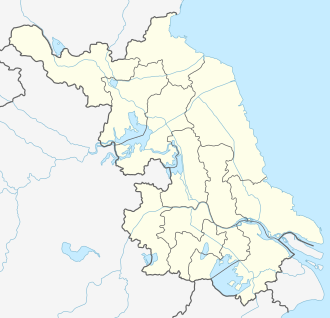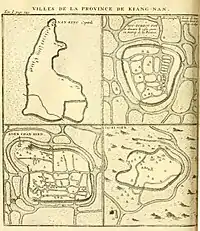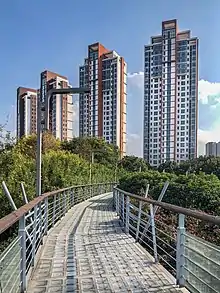Kunshan
Kunshan is a county-level city in southeastern Jiangsu province with Shanghai bordering its eastern border and Suzhou on its western boundary. It is under the administration of the prefecture-level city of Suzhou.
Kunshan
昆山市 | |
|---|---|
 Zhouzhuang, Kunshan | |
 Kunshan Location in Jiangsu | |
| Coordinates: 31°19′19″N 120°59′06″E | |
| Country | People's Republic of China |
| Province | Jiangsu |
| Prefecture-level city | Suzhou |
| Government | |
| • Party Secretary | Yao Linrong (姚林荣) |
| • Mayor | Du Xiaogang (杜小刚) |
| Area | |
| • Total | 931 km2 (359 sq mi) |
| Population (2019
[1]) | |
| • Total | 981,300 |
| • Density | 1,100/km2 (2,700/sq mi) |
| Time zone | UTC+8 (China Standard) |
| Postal code | 215300 |
| Area code(s) | 0512 |
| Vehicle registration plates | 苏EM, 苏EP, 苏EN, 苏EX |
| Website | www |
| Kunshan | |||||||||||||||||||||||||||||||||||||
|---|---|---|---|---|---|---|---|---|---|---|---|---|---|---|---|---|---|---|---|---|---|---|---|---|---|---|---|---|---|---|---|---|---|---|---|---|---|
| Kunshan | |||||||||||||||||||||||||||||||||||||
| Traditional Chinese | 崑山 | ||||||||||||||||||||||||||||||||||||
| Simplified Chinese | 昆山 | ||||||||||||||||||||||||||||||||||||
| |||||||||||||||||||||||||||||||||||||
Name
There is a strong possibility that the name Kunshan is derived from a hill, but which one is controversial.[2] According to an impacted version, the hill is present-day Little Kunshan (Xiaokunshan) in Shanghai's Songjiang District. The character 崑 (Kun) was the old Chinese name for the Kunlun Mountains. From it developed the Chinese idiom "a jade from Kunlun Mountains", meaning any "outstanding figure". This was applied to Lu Ji and a hill in his hometown was designated as Kun to commemorate him.[3]
History

Lou county (婁縣) which administered Kunshan and the area around was established in Qin dynasty. It was named after Lou River (婁江; present-day Liu River: 瀏河), while its seat was located in the north eastern of Kunshan. In 507, Xinyi county (信義縣) which hold Lou county 's former seat was separated from the old Lou county. In 535, the old Kunshan county was separated from the old Xinyi county, while its seat was moved to the north of Kun Hill, Songjiang. In 751, the seat was moved to the south of Ma'anshan (Ma'an Hill: 馬鞍山; in Kunshan nowadays). In 1724, then Kunshan county was divided into new Kunshan county and Xinyang county (新陽縣), the walled city also was halved to locate their own seat respectively. In 1860, Taiping Rebellions captured the walled city, then the Ever Victorious Army?recaptured it in 1863. On 11 November 1911, the local rally announced that both of the counties seceded from the Qing court from then on. In 1912, Xinyang county was merged into Kunshan county. On 15 November 1937, the Japanese army captured the walled city. On 13 May 1949, the CPC controlled the walled city.[4] On 28 September 1989, the county was turn into a county-level city.
Administration
Kunshan is divided into 10 towns:
|
|
However, both of Yushan and Huaqiao are nominal divisions at present, they even not to be listed in an official website. Kunshan New & Hi-tech Industrial Development Zone (昆山高新技术产业开发区, KSND) administering the main part of Yushan functions as the seat of the city, while Huaqiao Economic Development Zone (花桥经济开发区) administers the north of Huaqiao and Kunshan Economic & Technological Development Zone (昆山经济技术开发区, KETD) administers the east of Yushan.
On July 10, 2018, the Jiangsu Provincial Government approved the Master Plan of Kunshan for Urban Development (2017-2035), which is based on the master plan of the Xiong’an New Area. These zones include the Qingyang Port Waterfront City Center, the Duke Creative Park, the Kunshan South Gateway, the Chaoyang Road CBD and the Tinglin Park Traditional Culture Zone—in addition to the S1 Rail Line Corridor.[5]
Qingyang Port Waterfront City Center[5]
Covering an area of 3.4 sq km, the area is located in Kunshan’s city center. Planned as an ecological, cultural and smart area, it will include six zones—a media port, a cultural oasis, an urban lifestyle community, a waterfront park, a futuristic life experience center, and a youth entrepreneurship park. The area is designed to be a waterfront space that will enrich and diversify citizens’ urban life as the most environmentally attractive and economically prosperous hub in the city.
Duke Creative Park[5]
The park is located west of the city’s technology innovation cluster, covering an area of 3.84 sq km. It sits nearby three lakes, two industrial parks, and a town. With the support of Duke Kunshan University, the area will host the Sino-US (Kunshan) Technology Innovation Center and serve as a mixed-used project integrating R&D centers, business services, and ecological parks. It aims to become a global magnet for technology entrepreneurs and innovators.
Kunshan South Gateway[5]
The area is located around the city’s high-speed railway station, with an area of 1.6 sq km. While serving as a transportation hub integrating high-speed trains, rail transportation, and public buses, the area will develop businesses such as office spaces for lease, business services and recruitment agencies. As an open, innovative modern gateway, the area will become an important business cluster in the inter-city economic belt of Shanghai and Nanjing.
Chaoyang Road CBD[5]
The CBD covers an area of 5.55 sq km in the old city center of Kunshan. The area will be furnished with enhanced amenities and infrastructure according to a plan featuring “one ring, two axes, three centers and four zones”. The project aims to revive and transform the old city center into an exquisite and livable model business district.
Tinglin Park Traditional Culture Zone[5]
The zone is located at the foot of Yufeng Mountain, with a planned area of 0.73 sq km. It is designed with cultural and art parks, culture-oriented businesses and ecological and leisure facilities. It will epitomize the natural beauty and cultural richness of the city.
S1 Rail Line Corridor[5]
The line is 41 km long and will be completely constructed underground with 28 stops. The line will pass by all the major zones of the city and will significantly alleviate local traffic congestion. The project will be integrated with the surface transportation system and serve as a strong boost to the city’s renewal.
Geography
Topography
The area is relatively flat, but there is a gentle slope stretching from the south-east to north-west. The northern part consists of dense polder, while the southern part is dotted with various lakes. The major lakes are Dianshan Lake, Yangcheng Lake, Cheng Lake and Kuilei Lake. Wusong River winds through the city, while smaller rivers criss-cross it in a grid pattern.
Climate
| Climate data for Kunshan (1959−1987) | |||||||||||||
|---|---|---|---|---|---|---|---|---|---|---|---|---|---|
| Month | Jan | Feb | Mar | Apr | May | Jun | Jul | Aug | Sep | Oct | Nov | Dec | Year |
| Record high °C (°F) | 21.6 (70.9) |
25.4 (77.7) |
27.9 (82.2) |
32.4 (90.3) |
34.7 (94.5) |
35.7 (96.3) |
37.9 (100.2) |
37.6 (99.7) |
36.2 (97.2) |
32.5 (90.5) |
27.9 (82.2) |
23.2 (73.8) |
37.9 (100.2) |
| Daily mean °C (°F) | 2.8 (37.0) |
4.1 (39.4) |
8.2 (46.8) |
13.9 (57.0) |
19.1 (66.4) |
23.4 (74.1) |
27.7 (81.9) |
27.4 (81.3) |
22.8 (73.0) |
17.3 (63.1) |
11.6 (52.9) |
5.2 (41.4) |
15.3 (59.5) |
| Record low °C (°F) | −11.7 (10.9) |
−8.4 (16.9) |
−5.1 (22.8) |
−1.4 (29.5) |
6.0 (42.8) |
12.3 (54.1) |
16.6 (61.9) |
16.6 (61.9) |
11.0 (51.8) |
2.5 (36.5) |
−3.1 (26.4) |
−7.8 (18.0) |
−11.7 (10.9) |
| Average precipitation mm (inches) | 35.2 (1.39) |
52.1 (2.05) |
75.8 (2.98) |
101.1 (3.98) |
111.1 (4.37) |
159.3 (6.27) |
130.2 (5.13) |
120.6 (4.75) |
128.9 (5.07) |
62.2 (2.45) |
52.6 (2.07) |
34.6 (1.36) |
1,063.7 (41.87) |
| Source: Kunshan County Chorography[6] | |||||||||||||
According to the analysis of the local meteorological bureau, from 1961 to 2008, the annual and seasonal air temperatures were the increasing trends, especially in spring. The total precipitation remained static relatively, however, much concentrated in summer and winter.[7]
Economy

The composition of local GDP have changed drastically since 1978. In 1978, the primary sector, the secondary sector and the tertiary sector accounted for 51.4%, 28.9% and 19.7% respectively. However, the data in 2015 were 0.9%, 55.1% and 44.0%.[8] Kunshan is also home to over 1,000 hi-tech companies that have helped shape the city’s four economic pillars—optoelectronics, semiconductors, intelligent manufacturing, and RNAi and biomedicine.[5]
The total GDP of Kunshan was 316 billion RMB,[9] listed as No.1 of all Chinese county-level city in 2016.[10]
Kunshan is also home to many Taiwanese who have invested over the decades since China's opening up to the world in the late 70s.[11] Kunshan is also known as "Little Taiwan" because of the large Taiwanese community.[11] In 2020 the number of Taiwanese in Kunshan was above 100,000.[12]
The Chinese subsidiary of American Megatrends, American Megatrends Information Technology (Kunshan) Co., Ltd. (安迈信息科技(昆山)有限公司), has its headquarters in Kunshan.[13]
Culture
Kunqu Opera
Kunshan is the cradle of Kunqu opera which evolved from Kunshan tune. The tune was fused the Southern Operas and the Kunshan local cultural elements in the late Yuan dynasty, it was preferred by some scholars and dramatists since mid-Ming dynasty. Being improved by them, Kunshan tune became quite popular until the 1800s.
Kunshan Culture & Art Center
Kunshan Culture & Art Center situated in the west of the downtown is usually used as the venue for considerable local performances and conventions. The center is composed of a performing arts center, a convention center, a movie theater. Its first phase of the project is set in about 17.6 acres of land.[14]
Food identified with Kunshan
Recreation and tourism
Kunshan is one of the most visited tourist destinations among the Yangtze River Delta with over 20 million visits in 2016.[15]
The 2013 World Cyber Games were held Kunshan in order to draw in tourism and positive press.[16]
 Zhouzhuang Ancient Town
Zhouzhuang Ancient Town Qiandeng Ancient Town
Qiandeng Ancient Town Jinxi Ancient Town
Jinxi Ancient Town
 Bacheng Water Town
Bacheng Water Town
Education

There are two institutions in Kunshan issuing at least bachelor's degree:
- Duke Kunshan University
- Applied Technology College of Soochow University
The city also hosts a variety of primary and secondary schools, both public and private:
Transportation
Expressways
- G2 Beijing–Shanghai Expressway
- G1501 Shanghai Ring Expressway
- S5 Changshu–Jiaxing Expressway
- S48 Shanghai–Yixing Expressway
- S58 Shanghai–Changzhou Expressway
National Highway
Railway
- There is a Kunshan Railway Station on Jinghu Railway situated in the south of the downtown. It principally handles freight.
- Kunshan South Railway Station is a junction where Beijing-Shanghai High-Speed Railway and Shanghai–Nanjing Intercity High-Speed Railway link at. Besides, both Yangcheng Lake Railway Station and Huaqiao Railway Station are on the Shanghai–Nanjing Intercity High-Speed Railway.
Underground
A motion made to construct two metro railways running through the city center was passed by the Jiangsu provincial government.[20][21] Kunshan is the first county-level city with a metro railway system. Line 11, Shanghai Metro has been extended to Kunshan in 2013. An extension of Line 3, Suzhou Rail Transit to Kunshan has also been proposed.
Notable people
Literature
- Einar Tangen: Cities of China – Kunshan. The Kunshan Way. Beijing: Foreign Languages Press, 2010; ISBN 978-7-119-06432-1.
References
Citations
- Tabulation of the 2010 Population Censue of the People's Republic of China by County: Kunshan. China Statistics Press. 2012. ISBN 978-7-5037-6659-6.
- Wang (1990), pp. 73–74.
- 讀史方輿紀要, Vol. 24.
崑山,府西北二十三里。其西為長谷,亦曰華亭谷,有水縈繞百餘里,為泖湖之上源,故泖湖亦兼谷泖之名。杜佑曰:「華亭縣以華亭谷而名。」陸機臨命嘆曰:「華亭鶴唳,可復聞乎?」蓋其地嘗出鶴也。山之得名,亦以陸機兄弟生於此,取崑山出玉之義
- Wang (1990), pp. 11–68.
- "Kunshan releases "Five Zones, One Line" plan for urban renewal". Retrieved 2018-11-17.
- Wang (1990), pp. 111–114.
- "Characteristics of climate change from 1961 to 2008 in Kunshan, Jiangsu province". Journal of Meteorology and Environment. 26 (5): 53–56. 2010.
- "Kunshan Statistic Yearbook (2015)".
- "Main Economic Indicators of Kunshan (Jan-Dec 2016)".
- "Release of Scientific Development Index of Studies of Small to Medium Sized City in China 2017".
- Chien, Shiuh-Shen & Zhao, Litao. (2008). The Kunshan Model: Learning from Taiwanese Investors. Built Environment. 34. 427-443. 10.2148/benv.34.4.427.
- "Why commercial ties between Taiwan and China are beginning to fray". The Economist. 2020-11-19. Retrieved 2020-11-22.
- "International Offices." American Megatrends. Retrieved on February 17, 2019. "China: 安迈信息科技(昆山)有限公司 江苏省昆山市长江中路198号1号楼2101室 安迈信息科技(昆山)有限公司, 邮编215301 (American Megatrends Information Technology (Kunshan) Co., Ltd., Room 2101, Building 1, No. 198, Changjiang Middle Road, Kunshan City, Jiangsu, China 215301)"
- "Kunshan Culture & Art Center". www.ks.gov.cn.
- 昆山:2016年昆山接待游客突破2000万人次. www.jstour.gov.cn (in Chinese).
- Szablewicz, Marcella (March 2016). "China's E-Sports Paradox". Slate Magazine.
- "Home - CISK". www.ciskunshan.org. Retrieved 2018-11-17.
- "Kunshan Middle School Proposal / United Design Group". ArchDaily. 2013-01-24. Retrieved 2018-11-17.
- "Kunshan West High School Master Plan | Kunshan China | Integrated Planning and Design". World Landscape Architecture. 2013-07-24. Retrieved 2018-11-17.
- "省政府关于昆山市城市总体规划的批复". Archived from the original on September 30, 2011. Retrieved 2012-03-13.
- "昆山市城市总体规划 (2009—2030)". Retrieved 25 March 2014.
Bibliography
- Wang, Daowei (1990). Kunshan County Chorography (昆山县志). Shanghai People's Publishing House. ISBN 7-80519-404-1.
External links
| Wikimedia Commons has media related to Kunshan. |
